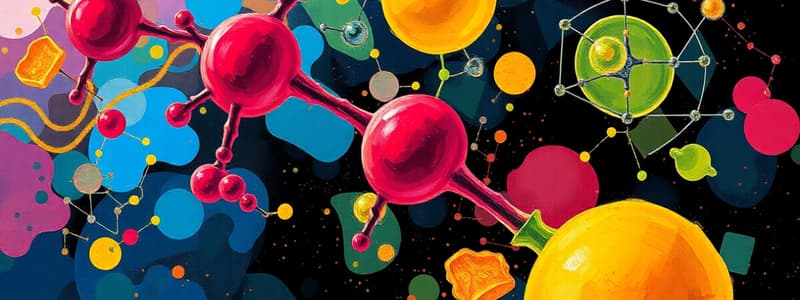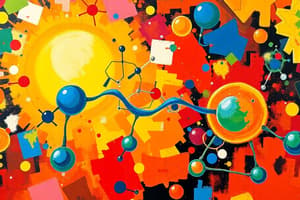Podcast
Questions and Answers
What causes the polarity of a water molecule?
What causes the polarity of a water molecule?
- Equal sharing of electrons between oxygen and hydrogen
- Oxygen is more electronegative than hydrogen (correct)
- Water has a symmetrical structure
- Hydrogen atoms are heavier than oxygen
Water molecules do not exhibit hydrogen bonding due to their nonpolar nature.
Water molecules do not exhibit hydrogen bonding due to their nonpolar nature.
False (B)
What type of charge does the oxygen atom carry in a water molecule?
What type of charge does the oxygen atom carry in a water molecule?
Partial negative charge (δ⁻)
In a water molecule, the oxygen atom pulls the shared electrons closer, creating an unequal sharing that results in a _____ charge for oxygen.
In a water molecule, the oxygen atom pulls the shared electrons closer, creating an unequal sharing that results in a _____ charge for oxygen.
Match the following terms related to water with their correct descriptions:
Match the following terms related to water with their correct descriptions:
Which of the following elements is NOT a key component of biological molecules?
Which of the following elements is NOT a key component of biological molecules?
Covalent peptide bonds are formed between nucleotides in nucleic acids.
Covalent peptide bonds are formed between nucleotides in nucleic acids.
What type of bond is formed when monosaccharides link together?
What type of bond is formed when monosaccharides link together?
Lipids are mainly composed of carbon (C), hydrogen (H), and ________ (O).
Lipids are mainly composed of carbon (C), hydrogen (H), and ________ (O).
Which of the following describes how proteins are formed?
Which of the following describes how proteins are formed?
What occurs during the formation of a peptide bond?
What occurs during the formation of a peptide bond?
Match the biological molecule with its key component:
Match the biological molecule with its key component:
The backbone of DNA is held together by ________ bonds.
The backbone of DNA is held together by ________ bonds.
Flashcards are hidden until you start studying
Study Notes
Key Elements in Biological Molecules
- Six key elements: Carbon (C), Hydrogen (H), Oxygen (O), Nitrogen (N), Phosphorus (P), and Sulfur (S) make up the building blocks of all biological molecules.
Covalent Bonds in Biological Molecules
- Carbohydrates: Composed of carbon, hydrogen, and oxygen. Monosaccharides (simple sugars) link together via dehydration synthesis, forming glycosidic bonds.
- Example: Sucrose (table sugar) is formed by a glycosidic bond between glucose and fructose.
- Proteins: Made of amino acids containing carbon, hydrogen, oxygen, nitrogen, and sometimes sulfur.
- Covalent peptide bonds form between amino acids when the carboxyl group of one reacts with the amino group of another, releasing water.
- Example: Enzymes and structural proteins are formed by long chains of amino acids connected by peptide bonds.
- Lipids: Mainly composed of carbon, hydrogen, and oxygen, with fewer oxygen atoms than carbohydrates.
- Covalent ester bonds form between glycerol and fatty acids via dehydration synthesis.
- Example: Triglycerides (fats and oils) are formed by three fatty acids covalently bonded to a glycerol molecule.
- Nucleic acids: Made of nucleotides containing a sugar, a phosphate group, and a nitrogenous base.
- Covalent phosphodiester bonds link nucleotides together, forming the backbone of DNA and RNA.
- Example: The sugar-phosphate backbone of DNA is held together by covalent bonds, while nitrogenous bases pair via hydrogen bonds.
Water: Polarity and Hydrogen Bonding
- Polarity: Unequal sharing of electrons in a water molecule results in a partial negative charge on the oxygen atom and partial positive charges on the hydrogen atoms.
- This makes water a polar molecule, with a positive and a negative end.
- Hydrogen Bonding: The partial positive charges on hydrogen attract the partial negative charges on oxygen atoms in neighboring water molecules.
- Weak hydrogen bonds form between water molecules, contributing significantly to water's properties.
Studying That Suits You
Use AI to generate personalized quizzes and flashcards to suit your learning preferences.



